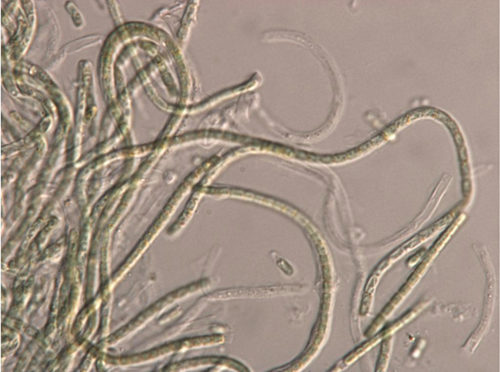Microbes for bioremediation have primarily focused on ability to break down the contaminants. But microbes can also remove contaminants from water or waste streams by converting them into a less toxic form that is then precipitated out of the liquid. These techniques have industrial applications as conventional wastewater treatment processes without microbial aid are inefficient and expensive, especially when it comes to extracting heavy metal contaminants present in low concentrations. Several algal strains are already being cultivated for microbially-mediated wastewater treatment, and researchers are working on identifying freshwater cyanobacteria with these bio-absorptive capabilities.

Photo: Filaments of JSC-12 seen through Nomarsky mode of microscopy.
(Courtesy of Igor Brown, NASA Johnson Space Center)
In this project, researchers plan to sequence the genomes of two iron-tolerant cyanobacteria sampled a bacterial mat found in the Chocolate Pots hot spring at Yellowstone National Park in Wyoming. Like other cyanobacteria in this hot spring, both bacteria possess the ability to deposit and dissolve iron-rich minerals and rocks. One bacterium is a strain of Fischerella while the other belongs to a group of “uncultured” Antarctic cyanobacteria, and one of the questions researchers are interested in looks at why several cyanobacterial species found in Yellowstone hot springs and Antarctica are closely related to each other. Sequencing these strains will also allow researchers to better understand how biogeochemical processes are driven by cyanobacteria, as well as lead to the development of new approaches for the bioremediation of iron-polluted environments.
Principal Investigators: Igor Brown, NASA Johnson Space Center
Program: CSP 2010